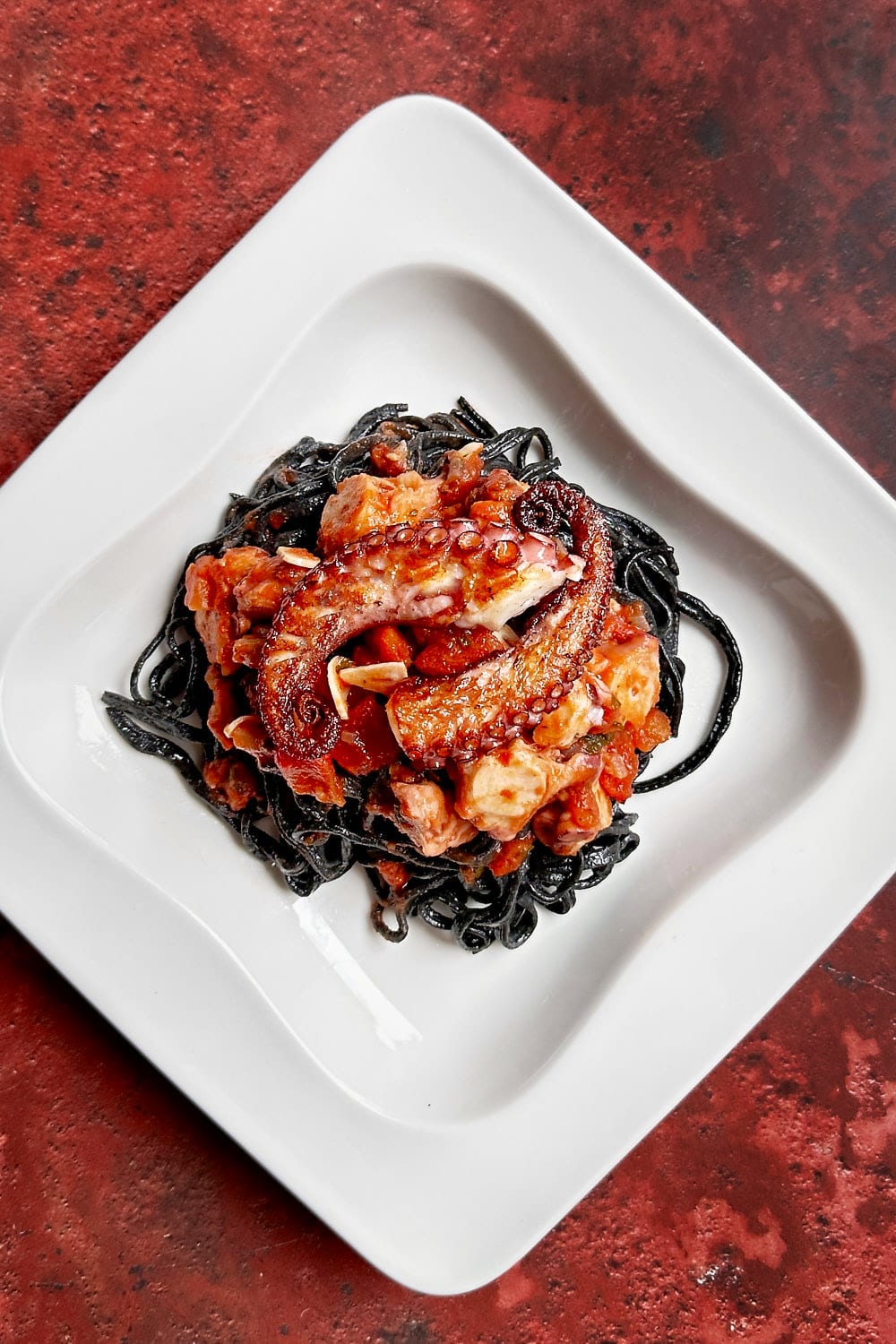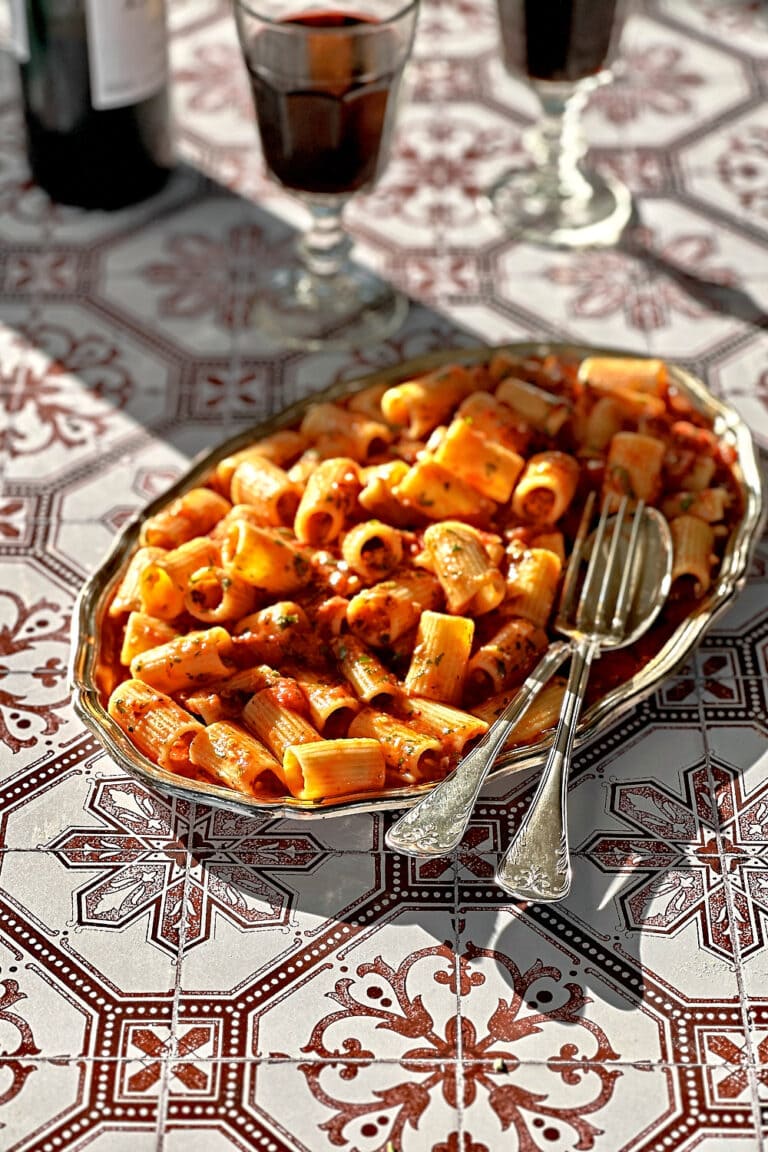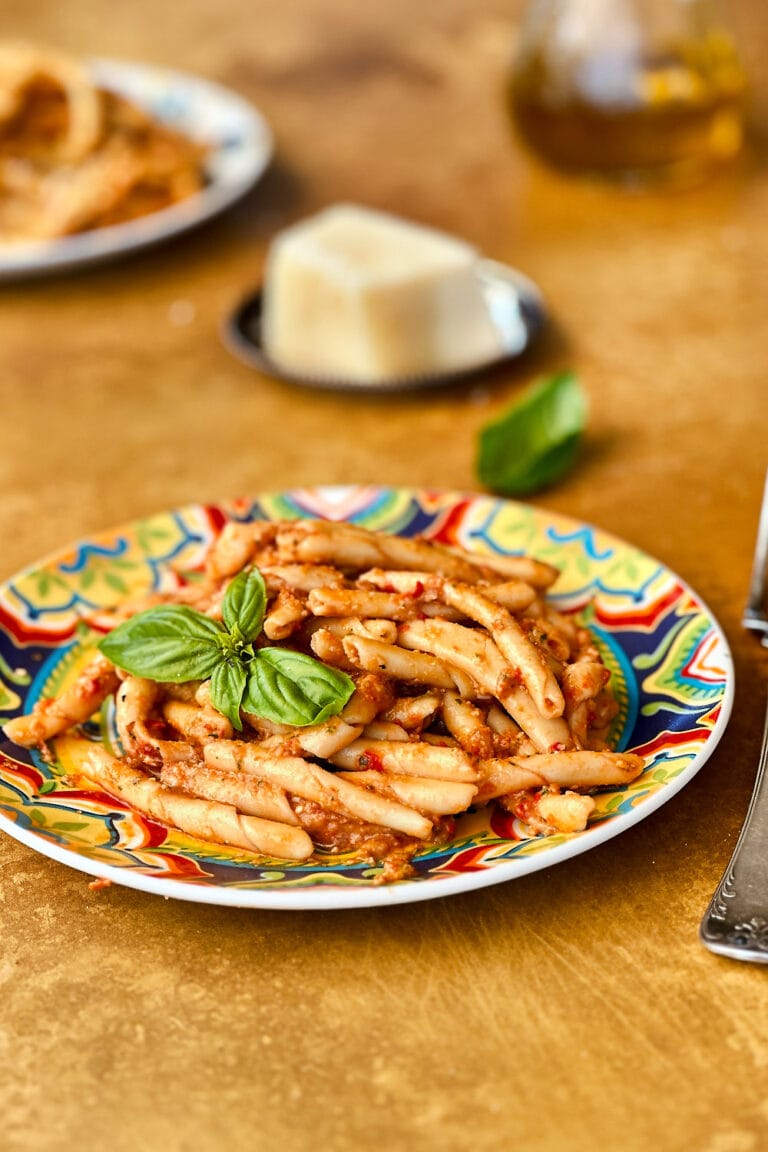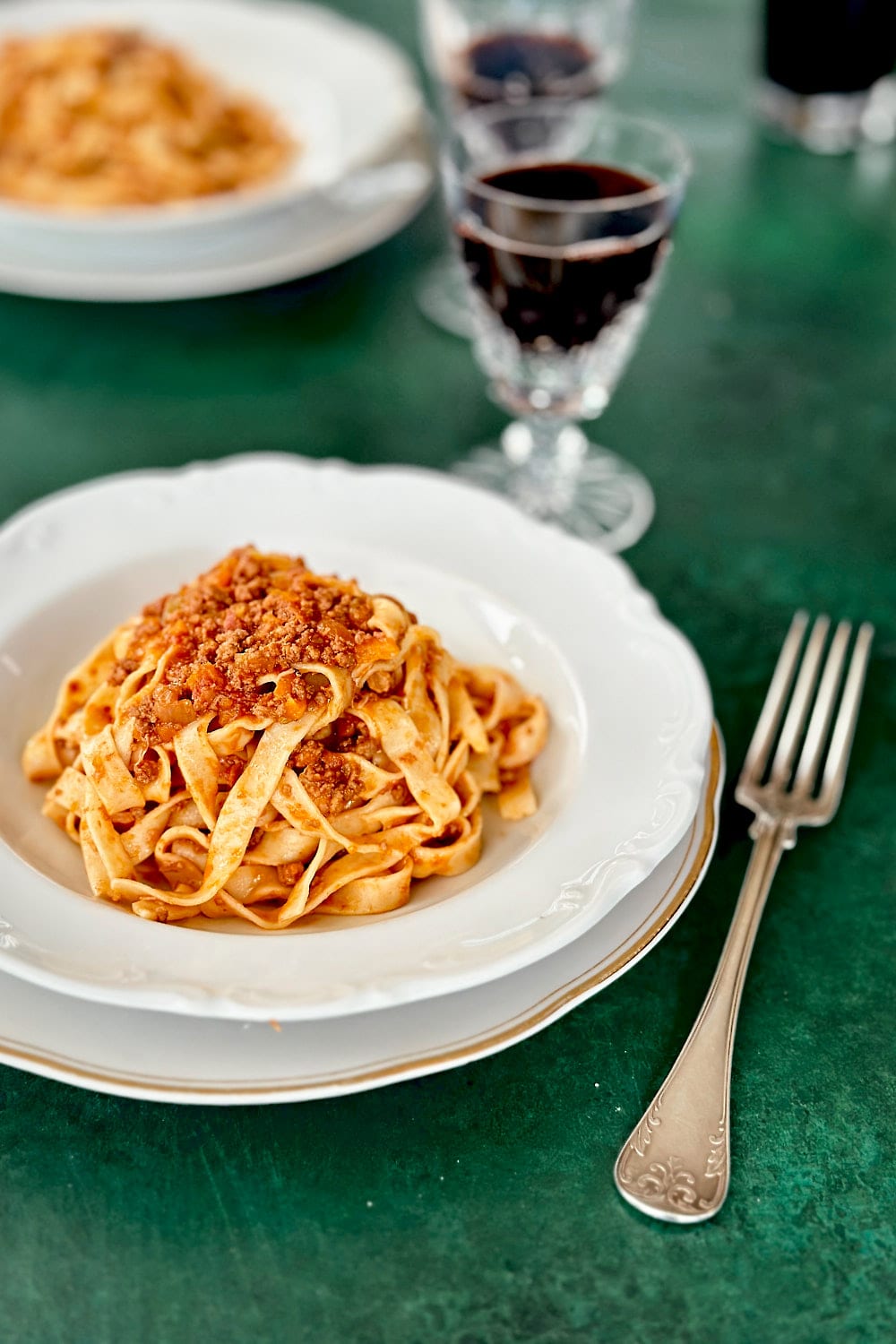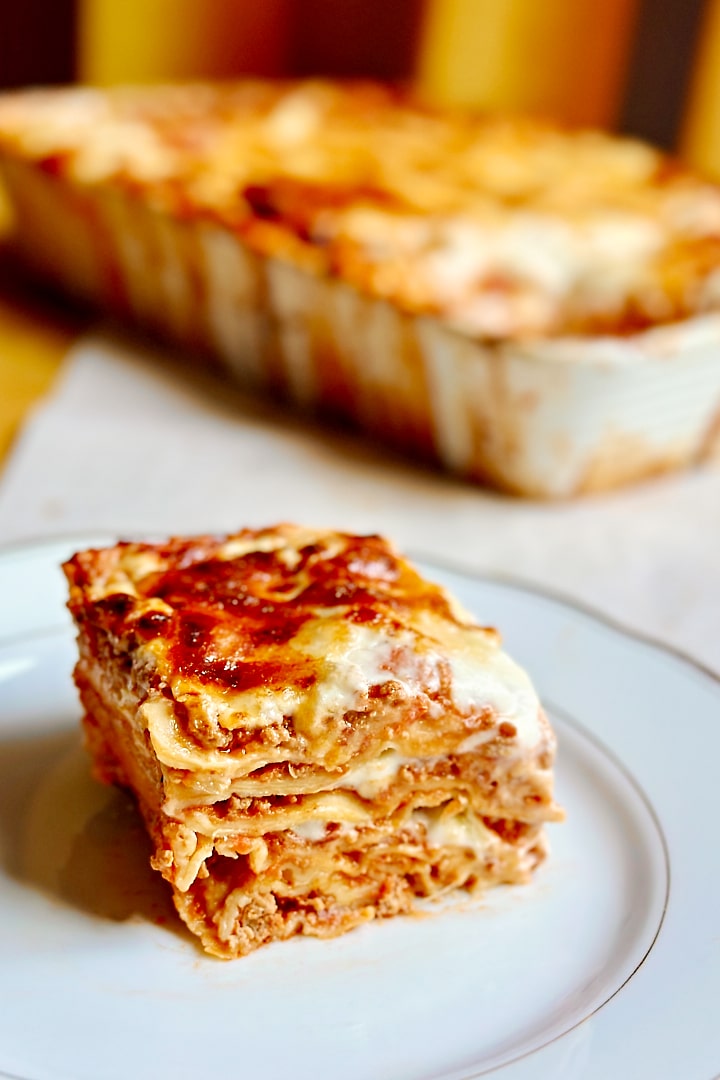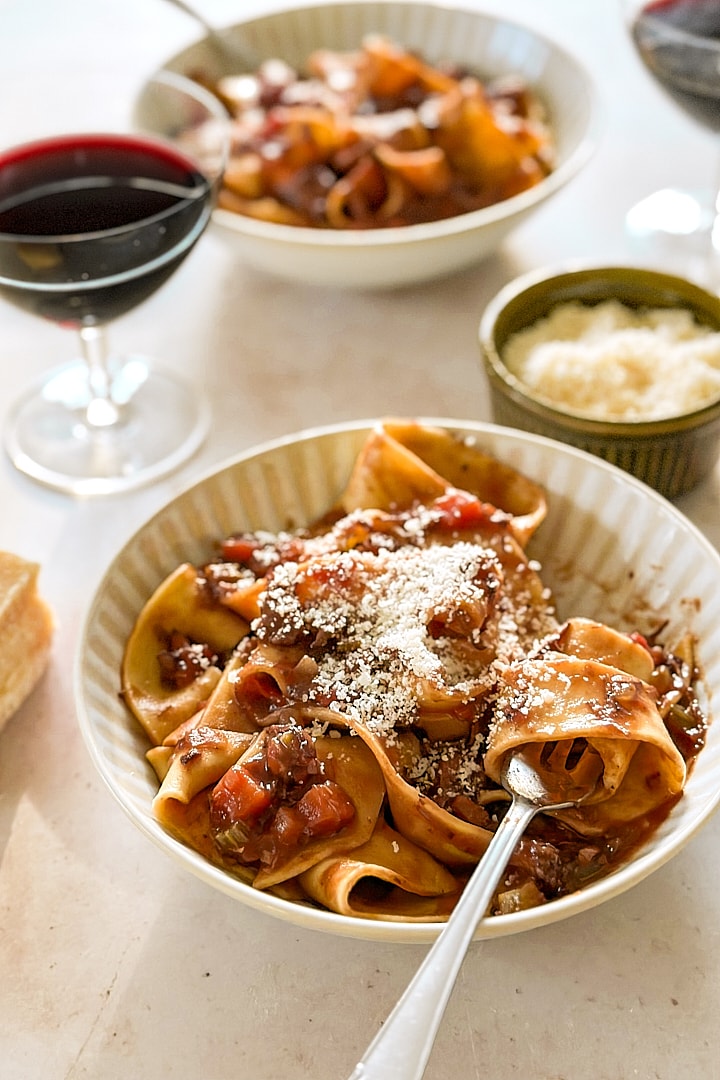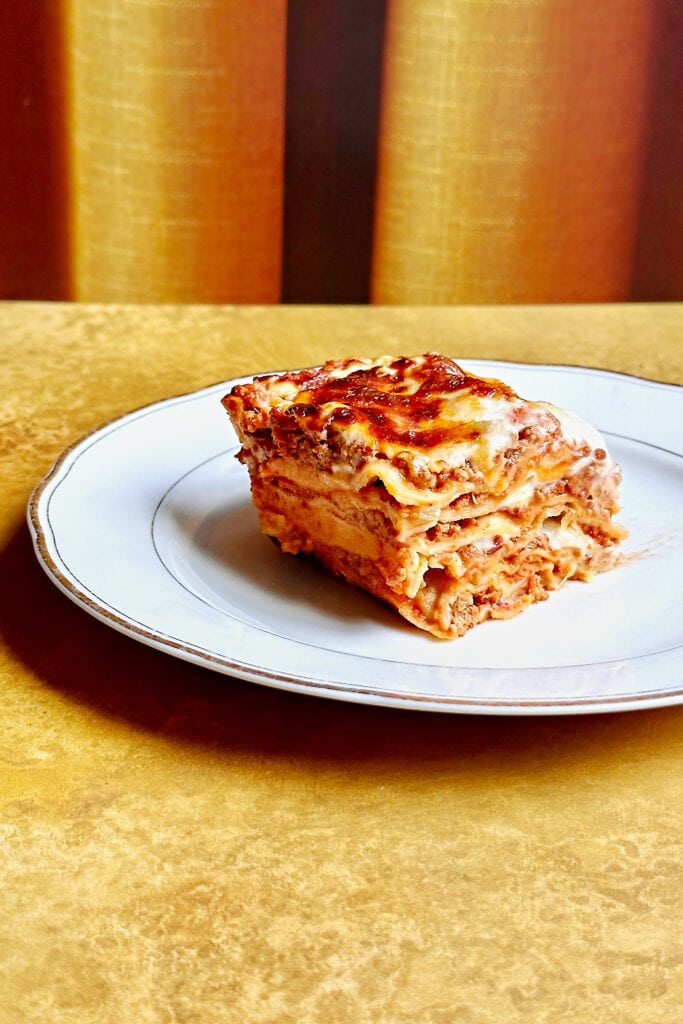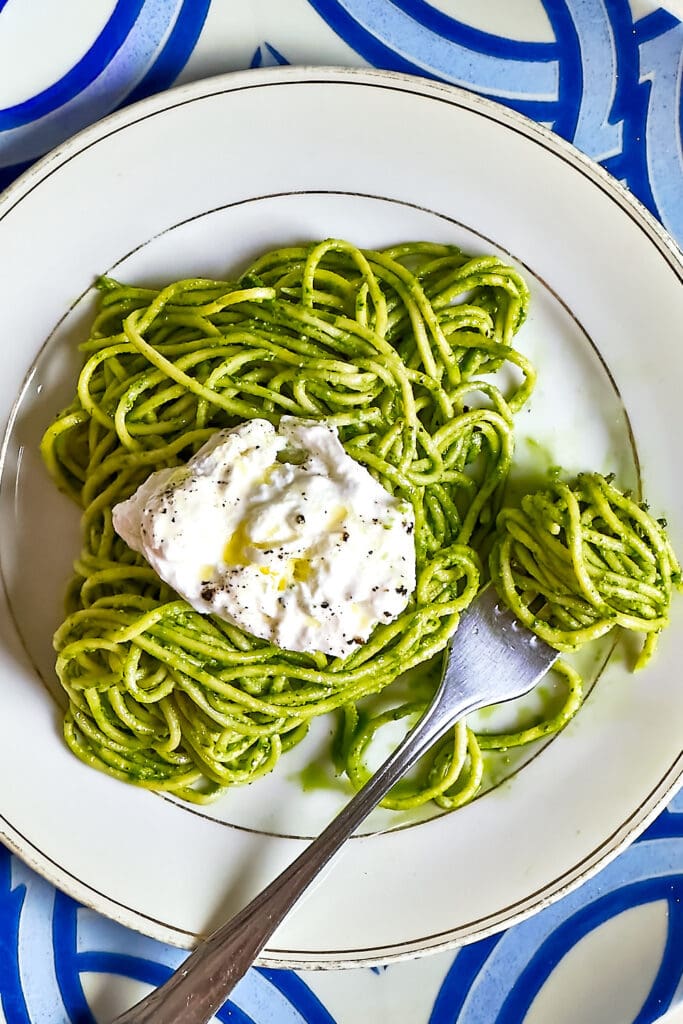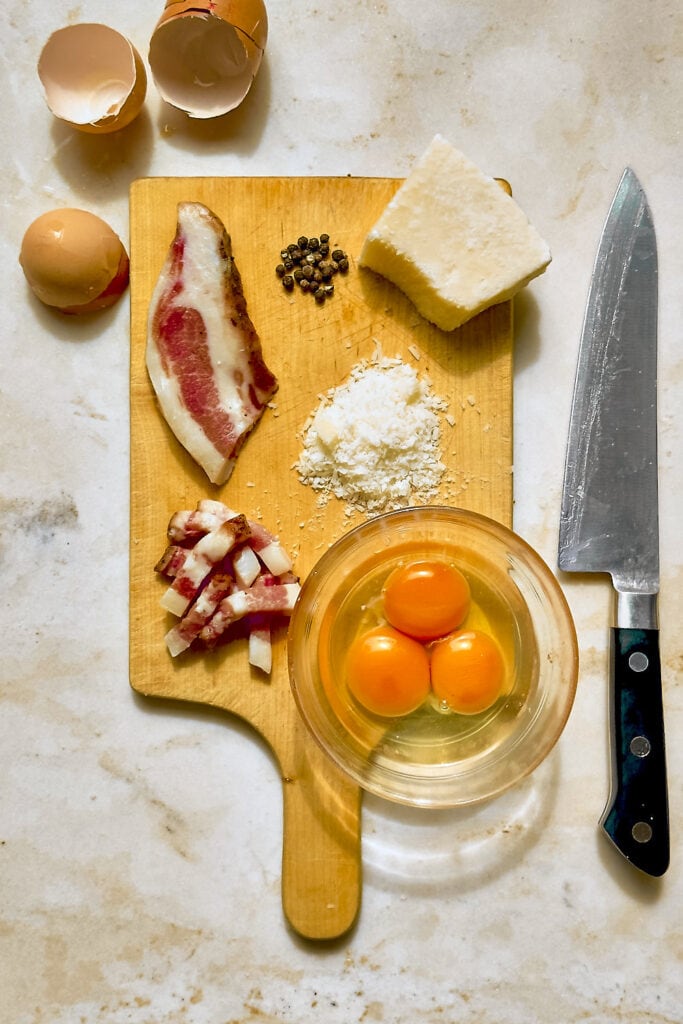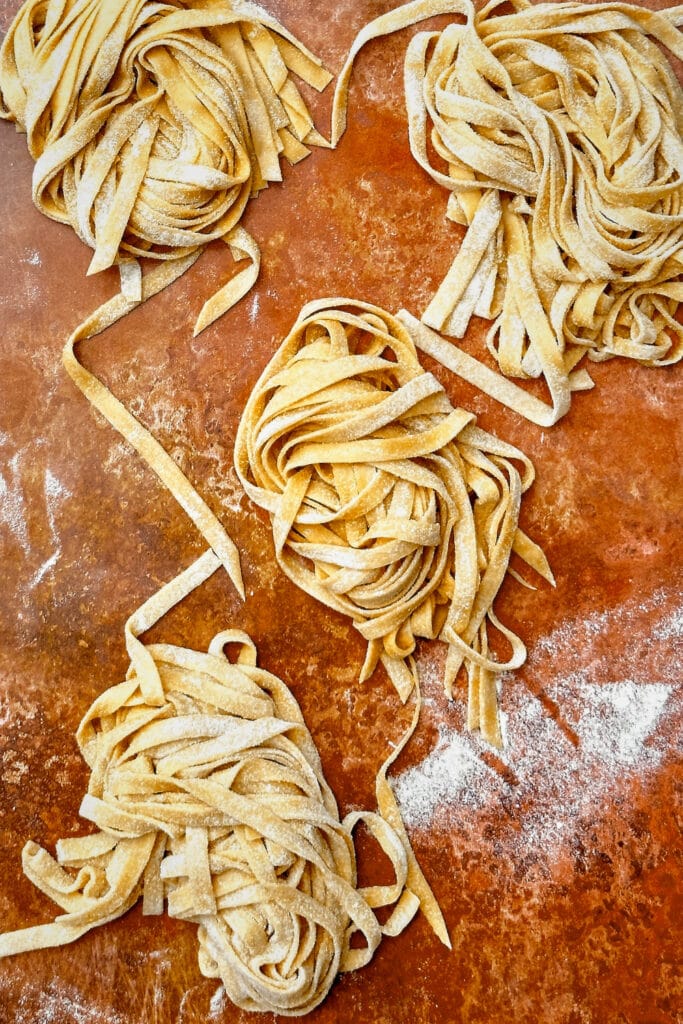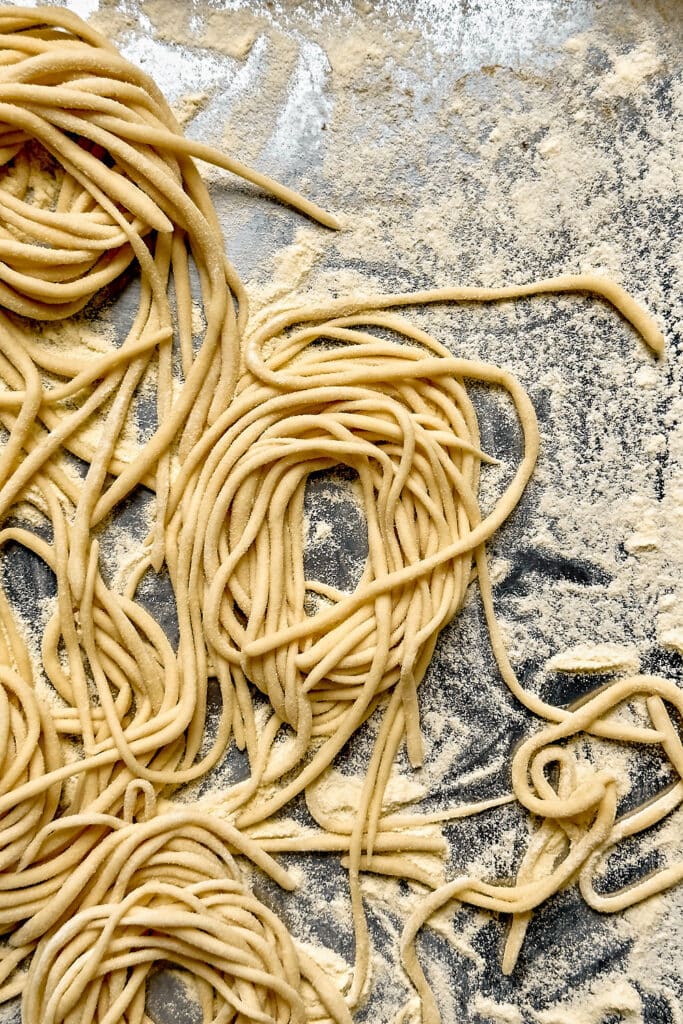Easy Octopus Pasta Recipe With Spicy Tomato Sauce
If you love seafood, this octopus pasta recipe is for you! It combines tender octopus with a mildly spicy tomato sauce and is served with homemade squid ink pasta. A sophisticated and delicious meal that will surely impress your guests.

Ingredients and Tools You’ll Need


Step-by-Step Instructions
Step 1
Prepare the octopus: If using frozen octopus, let it thaw in the fridge for at least 24 hours and make sure it’s completely thawed before cooking. Don’t defrost it in the microwave or oven. Once it is fully thawed, use a sharp knife or kitchen shears to remove the beak (the hard mouth part in the center of the octopus where the tentacles intersect) and the eyes of the octopus. If you buy octopus at a fishmonger, it is usually already cleaned, with the internal organs and ink sac taken out. After you remove the beak and the eyes, you are left with the octopus tentacles and the mantle, which are both edible and will be used for this recipe. Rinse the octopus well under cold running water to remove any dirt or impurities.
Step 2
Make the broth: Cut the carrots into smaller pieces. Peel and smash the garlic cloves. Add some olive oil to a large pot over medium heat. Cut one red onion in half and add it to the pot with the cut-side down. Add the carrots and garlic. Sauté the vegetables for a few minutes, then add the white wine, water, parsley, salt, and vinegar. Cover the pot with a lid and bring it to a boil.
Step 3
Cook the octopus: Dip the tentacles into the boiling water for a few seconds and then remove them again. Do this 2 – 5 times, and then lower the whole octopus into the water. Blanching the tentacles first, makes them curl up and tenderizes the meat, resulting in a better texture and more appealing appearance. Cover the pot and bring the liquid to a simmer. Lower the temperature and keep the octopus at a gentle simmer for around 1 – 1.5 hours, until it becomes tender. The meat should be easy to pierce with a fork but still have a slight firmness. When it is tender, use tongs or a slotted spoon to remove it from the water. Let it sit for a while until it’s cool enough to handle. Then cut it into bite-sized pieces.
Step 4
Make the pasta: While the octopus is cooking, make one batch of squid ink pasta dough. Pile the flour on your work surface and create a well in the center. Crack the eggs into the center and add the cuttlefish ink. Start by scrambling the eggs with a fork and mix them with the squid ink until the liquid turns completely black. Add some flour from the sides of the well, stirring it in until a thick paste forms in the center. Using a bench scraper, fold in the rest of the flour until it turns into a shaggy dough. Knead the dough with your hands for about 10 minutes, until smooth and firm. Wrap it in plastic wrap and let it rest at room temperature for 30 minutes.
After the bench rest, cut off one quarter of the dough and keep the rest well wrapped. Using a pasta machine, roll the dough into a thin pasta sheet. For this recipe, I stopped rolling at setting 5 and used the Tagliolini cutter attachment to cut thin, spaghetti-like ribbons. If you prefer wider ribbons, you can make pappardelle or tagliatelle. Dust the ribbons with flour to prevent sticking, and shape them into little pasta nests. Store them on a floured baking tray. Repeat the process with the remaining dough.

Step 5
Make the octopus ragu: Chop the red onion and thinly slice the garlic cloves. Heat the olive oil in a large pan over medium-high heat. Sauté the onion for 4-5 minutes, until softened. Add the garlic and octopus pieces and cook for another 2-3 minutes until fragrant, but don’t let the garlic brown, or it might become bitter. Add the white wine, bring it to a simmer, and let it reduce by half. This may take 5-10 minutes. Add the diced tomatoes and the chopped parsley. Season with salt, pepper, and chili flakes. Simmer on low heat for 15 – 20 minutes.
Step 6
Cook the pasta: Bring a large pot of water to a rolling boil and add salt. Cook the pasta for about 1 – 2 minutes, until al dente. Keep in mind that fresh pasta cooks quickly. Check frequently to see if it’s done to your liking. If you use store-bought pasta, cook it according to the packet instructions. Drain the pasta and serve it immediately with the octopus ragù. Enjoy!
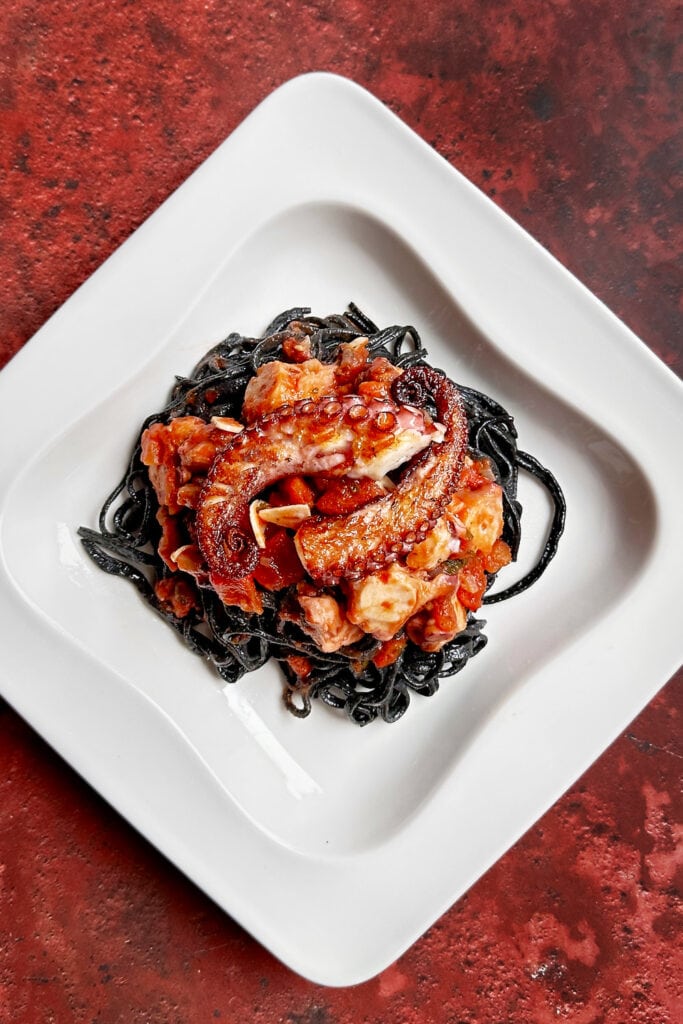
Tips & Tricks
More Pasta Recipes You May Like:

Easy Octopus Pasta With Spicy Tomato Sauce
Equipment
- Pasta machine
- Baking tray
- Pasta pan
Ingredients
For fresh squid ink pasta:
- 400 g flour
- 208 g eggs (weighed without shells) – about 4 medium eggs
- 20 g squid ink – usually available at fishmongers or online retailer
For the broth:
- 1 red onion
- 3 carrots
- 3 garlic cloves
- 1/2 bunch of parsley
- 250 ml dry white wine
- 3 l water
- 1 tbsp apple cider vinegar
- 1 tbsp salt
For the octopus ragù:
- 1 whole octopus – about 1 – 1.5 kg
- 4 tbsp olive oil
- 1 red onion
- 7 garlic cloves – thinly sliced
- 250 ml dry white wine
- 800 g diced, canned tomatoes – 2 cans
- salt and pepper to taste
- chili flakes – optional
- chopped parsley – to garnish the pasta
Instructions
- Prepare the octopus: If using frozen octopus, let it thaw in the fridge for at least 24 hours and make sure it’s completely thawed before cooking. Don’t defrost it in the microwave or oven. Once it is fully thawed, use a sharp knife or kitchen shears to remove the beak (the hard mouth part in the center of the octopus where the tentacles intersect) and the eyes of the octopus. If you buy octopus at a fishmonger, it is usually already cleaned, with the internal organs and ink sac taken out. After you remove the beak and the eyes, you are left with the octopus tentacles and the mantle, which are both edible and will be used for this recipe. Rinse the octopus well under cold running water to remove any dirt or impurities.
- Make the broth: Cut the carrots into smaller pieces. Peel and smash the garlic cloves. Add some olive oil to a large pot over medium heat. Cut one red onion in half and add it to the pot with the cut-side down. Add the carrots and garlic. Sauté the vegetables for a few minutes, then add the white wine, water, parsley, salt, and vinegar. Cover the pot with a lid and bring it to a boil.
- Cook the octopus: Dip the tentacles into the boiling water for a few seconds and then remove them again. Do this 2 – 5 times, and then lower the whole octopus into the water. Blanching the tentacles first, makes them curl up and tenderizes the meat, resulting in a better texture and more appealing appearance. Cover the pot and bring the liquid to a simmer. Lower the temperature and keep the octopus at a gentle simmer for around 1 – 1.5 hours, until it becomes tender. The meat should be easy to pierce with a fork but still have a slight firmness. When it is tender, use tongs or a slotted spoon to remove it from the water. Let it sit for a while until it’s cool enough to handle. Then cut it into bite-sized pieces.
- Make the pasta: While the octopus is cooking, make one batch of squid ink pasta dough. Pile the flour on your work surface and create a well in the center. Crack the eggs into the center and add the cuttlefish ink. Start by scrambling the eggs with a fork and mix them with the squid ink until the liquid turns completely black. Add some flour from the sides of the well, stirring it in until a thick paste forms in the center. Using a bench scraper, fold in the rest of the flour until it turns into a shaggy dough. Knead the dough with your hands for about 10 minutes, until smooth and firm. Wrap it in plastic wrap and let it rest at room temperature for 30 minutes.After the bench rest, cut off one quarter of the dough and keep the rest well wrapped. Using a pasta machine, roll the dough into a thin pasta sheet. For this recipe, I stopped rolling at setting 5 and used the Tagliolini cutter attachment to cut thin, spaghetti-like ribbons. If you prefer wider ribbons, you can make pappardelle or tagliatelle. Dust the ribbons with flour to prevent sticking, and shape them into little pasta nests. Store them on a floured baking tray. Repeat the process with the remaining dough.
- Make the octopus ragù: Chop the red onion and thinly slice the garlic cloves. Heat the olive oil in a large pan over medium-high heat. Sauté the onion for 4-5 minutes, until softened. Add the garlic and octopus pieces and cook for another 2-3 minutes until fragrant, but don’t let the garlic brown, or it might become bitter. Add the white wine, bring it to a simmer, and let it reduce by half. This may take 5-10 minutes. Add the diced tomatoes and the chopped parsley. Season with salt, pepper, and chili flakes. Simmer on low heat for 15 – 20 minutes.
- Cook the pasta: Bring a large pot of water to a rolling boil and add salt. Cook the pasta for about 1 – 2 minutes, until al dente. Keep in mind that fresh pasta cooks quickly. Check frequently to see if it’s done to your liking. If you use store-bought pasta, cook it according to the packet instructions. Drain the pasta and serve it immediately with the octopus ragù. Enjoy!
Video
@notjustfood_blog This octopus pasta ist for the seafood lovers 🐙 It combines tender octopus with a spicy tomato sauce and fresh squid ink pasta ✨ #octopus #octopuspasta #polpo #pastaconpolpo #squidinkpasta #freshpasta #cooking #pastarecipe #pastatiktok ♬ La Dolce Vita

